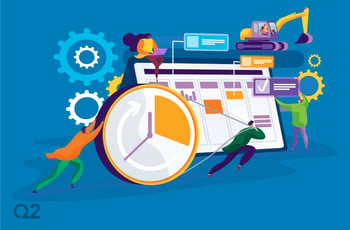Digitalisation has been a hot topic in the world of asset finance for years, and the pandemic has only further accelerated the pressure for asset finance organisations to adopt new technologies. But how can they decide where to focus? And how can they determine which aspects of pandemic life are here to stay?
At a recent International Asset Finance Network (IAFN) virtual gathering, Q2 Lending’s Vice President of Industry Solutions Mukul Mittal and Senior Sales Director in London Ian Nelson, Salesforce’s Head of Financial Services Alan Donnelly, and Shawbrook Bank’s Head of Fintech Strategy & Commercialisation Stuart Doignie, offered their thoughts on asset finance digitalisation in the next normal. All agreed that accelerating digitalisation right now greatly benefits asset finance organisations while offering their insights and experiences about its impact. They also addressed whether working from home is operational and whether it will it last.
Innovation is critical right now and moving ahead
To combat the ever-changing environment, asset finance companies need to be constantly innovating. Mukul Mittal stressed that “cost of operations and speed of transaction processing have to come down. Otherwise, you’re not competitive.” Specifically, he drew attention to the importance of using Straight-Through Processing (STP) to advance automation, improve workflows, and achieve business objectives. Despite some organisations engaged in “semi-manual” processing, Mittal said full automation through STP is needed to meet the needs of customers in these uncertain times and improve operational efficiencies.
The round table participants emphasized that businesses that began digitalisation prior to the pandemic have a marked advantage over those that have been slower to adopt new tools and processes. Some earlier adopters have even seen an increase in revenue during this time, while those lagging behind have seen their volumes suffer significantly. Stuart Doignie of Shawbrook Bank stated that being on the frontend of adoption curve “doesn’t mean we lose our identity or that we have to operate completely differently.” Instead, he said, “It gives us the opportunity to automate where we want to automate, and give more of a human touch where we want to give a human touch.”
The panelists agreed that what’s critically needed to catch up and move forward is leadership alignment and speed to market.
Adopting new technologies faster
When it comes to vetting and implementing new solutions, Alan Donnelly of Salesforce provided insight from the interactions he’s been having with customers. “Ultimately, what we’ve learned from our customers is that many felt the business model, the business processes, and in some cases the products and services they offered, are not fit for the future.” Taking an accelerated approach to adoption requires them to “prioritize and reprioritize projects and programs for the next two to three years. What was coming two years out is now coming six months out.”
Access to data and the ability to manage debt will continue to be important priorities. Q2’s Ian Nelson reiterated that there are a lot of new unknowns, and that “what we’ve learned from this [pandemic] is that it’s quite difficult to predict the future.” One key component to being prepared is “having data access, linking systems together through your APIs, being able to bring information together, and cross-reference it. That is probably the key to managing this.” When it comes to debt management, Nelson bluntly stated, “You don’t need to be a rocket scientist to recognize the coming tsunami in relation to bad debit and the management of bad debt.”
Adopting and implementing new technology can be complex for several key reasons. Mittal said the reality is that “there are two parts to any digitalisation process: one is the solution and the second is the adoption or change management.” While decision makers are looking for pre-packaged and easy to implement solutions, “the complexity is in identifying the right change management leaders within your organisation who will take it and drive value quickly so that sceptics get on board.”
Working from home: past, present, and future
All those on the round table agreed the continuing “work from home reality” poses both challenges and benefits to accelerating digitalisation and continuing growth. At the end of the day, fostering relationships and building trust with customers is absolutely critical in asset finance. Therefore, companies simply must be able to prioritise customer interactions and experiences in order to keep them happy during a time when the ability to meet in person is not a viable option.
Nelson has found that “ultimately, digitalisation in the asset finance market brings an omni-channel approach. From the immediacy of being able to work from home and satisfy customers at a high level, it works very well.” For companies in the next normal, whether they are still educating themselves on new trends, reprioritising or accelerating new technology, or sorting through the complexities of a fully remote workforce, resilience and speed are crucial to survival.
Collections challenges
Nelson added that collections is particularly challenging during this time because many in asset finance lack the readily available digital toolsets to fully facilitate it. He added that with a cultural shift and the right training, Q2’s collections solution with its data gathering capabilities and automated processes will bring a much-needed remedy.
If you’re interested in learning more about digital transformation in leasing, Q2’s VP of Industry Solutions Mukul Mittal offers his thoughts in this blog, The New Urgency: Automating Lease Management.
You and your asset finance company can learn more about STP and the expectations of the post COVID-19 customer by reading the Q2 ebook, The High Cost of Lending Uncovered.





